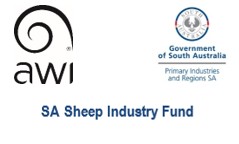Name:
Simon and Marissa Veitch
Location:
Kangaroo Island
Average Rainfall:
500 mm
Enterprises:
2,400 adult Merinos, 19 micron. 200 cows and calves, 200 yearlings
Farm Area:
1,380 ha (1,050 ha arable) including leased property, 300 ha crop (wheat, canola and lupins)
Third generation Kangaroo Island farmer Simon Veitch along with his wife Marissa has expanded his family business into new enterprises and directions since
he started full-time farming in 2010.
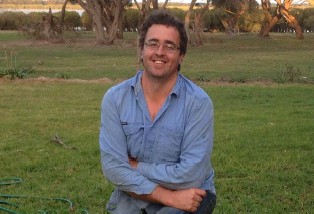
Simon Veitch on his KI property
When Simon returned to the farm, it was a pure beef run operation on the original holding with his father Wayne, who was well known for his eye for cattle. But the family changed the enterprise mix to include Merinos, introduced cropping and leased more land.
Simon says the push into new enterprises was to increase business profitability.
“Leasing was the quickest way to increase the land-holding without incurring the massive debt of land purchase,” he said.
“Introducing sheep into the farming mix has increased my labour use efficiency. Mixing cropping and sheep allows for higher stocking rates.”
“I went for Merinos as they were a better match for the MacGillivray growing season. Plus being a cattle property, the fences are certainly not going to hold cross-breeds in and I didn’t want the massive cost, in dollars and time, that re-fencing would incur. I currently run 200 Simmental-Angus cows plus calves and 200 yearlings on 300 ha, 2,400 adult fine wool Merinos’ on 400 ha and crop 300 ha of leased land in a wheat, canola, lupin or hay mix rotation.”
Simon completed a Bachelor of Agriculture at the University of Adelaide, worked as an agronomist with CRT in the South East and then Elders at Kingscote before returning home.
“I always knew I wanted to work in agriculture and my goal was to return home and manage the family farm. I enjoy the challenge of farming, most of the time, and putting into practice what I learnt from my time off the island and what I’m continuing to learn each day.”
When the next generation returns to the farm, succession is a key consideration and the Veitch family has been proactive and already started discussions, seeking professional advice.
They say having an ‘outsider’ who is independent of the family can help remove some of the emotion and ensure all those involved can have their say.
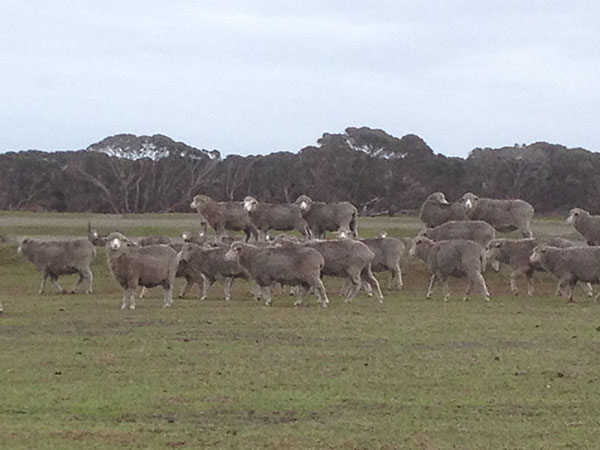
Merino ewes on the Veitch property
Simon makes the most of technology to make farming easier. His mantra is “if I can measure it, I can monitor it and then know how to improve it”. He uses worm egg counts to know when to drench, soil tests to calculate fertiliser and liming rates and feed tests his grain and hay to calculate the most cost-effective feed rations for stock during the dry periods.
He finds ‘Pastures from Space’ a useful tool especially now that he has access to it on his iPhone. Pastures from Space enables farmers to assess their pasture growth using satellite imagery. Whilst it’s a valuable tool there are some issues with resolution, meaning it can be hard to pick trends within a paddock. Its real value is management at the whole paddock level. Being able to download all the historical pasture growth rates for the property is great for looking at longer-term trends. Simon is hopeful that new generation pasture mapping tools will overcome the resolution issue and have more frequent updates (weekly being ideal)
“It’s a great time saver during busy times like seeding when I can simply monitor pasture paddocks from my phone. While it doesn’t remove the need for physically checking some paddocks and stock condition, it’s a great guide as to which paddocks actually need a physical check, rather than wasting a whole day driving around checking all the paddocks. And to be honest if I didn’t have access to the satellite data I would not be out recording pasture growth rates manually!”
Future directions for the farm include an increased focus on the sheep enterprise to build numbers to around 2000 ewes. The key driver of profitability is kilograms of wool per hectare.
Simon is not currently using EID as he is still in the build-up phase with livestock numbers so is not heavily culling stock. In the future, he will look into its potential value as a management tool.
The Veitch's have been benchmarking business performance for about five years with local vet Greg Johnsson and Holmes and Sackett. Having the benchmarking data was essential in enabling Simon to decide on his enterprise mix. “The farm was originally just a beef enterprise and I realised I needed to diversify to increase the farm profitability. The benchmarking data enables me to identify my key profit drivers and costs. It enables me to track progress and compare costs and returns against other KI operators”.
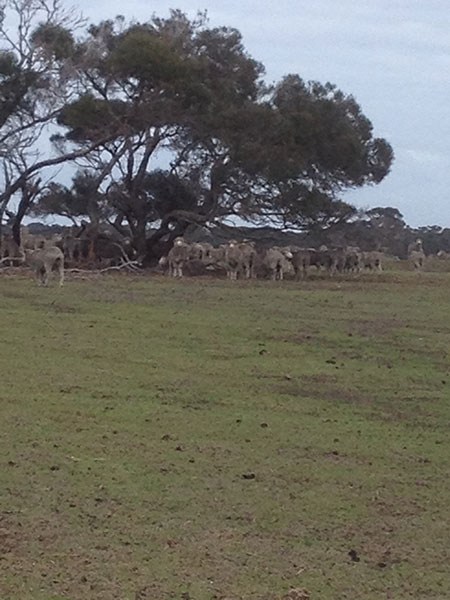
The Veitch Property
“To me there are two parts of benchmarking” Simons added.
“There is the clear analysis of how the farm business is performing and then there is the ability to compare your operations to others to truly know how well you are tracking. Your tax return just doesn’t show you that sort of data, benchmarking shows you your wealth creation and trends in production/ha. It’s the only way to really know what’s going on in your business”
Simon uses Australian Sheep Breeding Values to take the guesswork out of ram selection. Lambing takes place in July to match ewe feed demand to pasture growth and aims to keep ewes in score 3, helping to maximise lambing percentage.
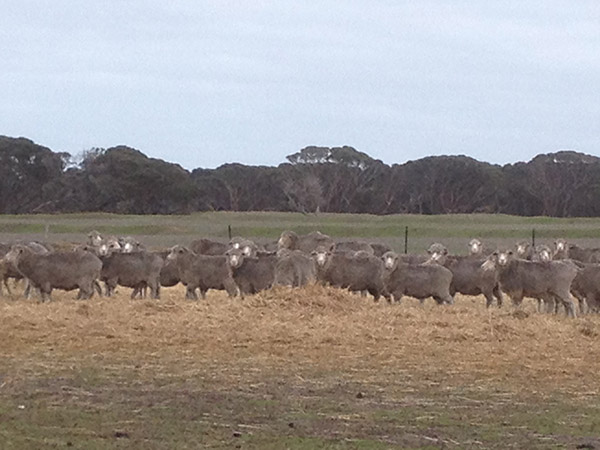
Feeding ewes at the Veitch property
The family runs Simmental-Angus cattle as a simple cross-breeding program, using hybrid vigour to maximise beef weight per hectare. A move from calving
in March to June/July has significantly reduced hand feeding costs. The other key change that has reduced costs and increased kilograms of beef/ha
has been the move from selling weaners to growing the cattle out to 450kg. This enterprise shift enables Simon to run more head of cattle with
fewer cow/calf units and bulls.
Prepared by Lyn Dohle, Primary Industries and Regions SA: Rural Solutions SA (2018). Adapted from case study written by Lyn Dohle funded by the Kangaroo Island Natural Resources Management Board
Print Case Study.
This project is supported by AWI, Primary Industries and Regions SA and SA Sheep Industry Fund.
